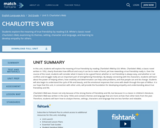In Unit 5, students explore concepts of perimeter and geometry. Students have gradually built their understanding of geometric concepts since Kindergarten, when students learn to name shapes regardless of size and orientation. They also learn to distinguish between flat and solid shapes. In Grade 1, students’ understanding grows more nuanced, as they learn to distinguish between defining and non-defining attributes, as well as compose and decompose both flat and solid shapes. In Grade 2, students draw and identify shapes with specific attributes. All of this understanding gets them ready for Grade 3, in which students begin their journey of measuring those attributes, including area (addressed in Unit 4), and perimeter (explored here), as well as classification of shapes based on attributes into one or more categories.
Students begin the unit by defining perimeter as the boundary of a two-dimensional shape and measure it by finding its length. For a polygon, the length of the perimeter is the sum of the lengths of the sides. They develop their understanding of perimeter by measuring it with a ruler, finding it when all side lengths are labeled, and then finding it when some information about the length of a shape’s side lengths needs to be deduced, such as when a rectangle only has its length and width labeled. Students then solve real-world and mathematical problems, both given a figure and without one, involving perimeters of polygons (3.MD.8). With this understanding of perimeter, they are able to compare the measurement of area and perimeter of a rectangle, seeing that a rectangle with a certain area can have a variety of perimeters and, conversely, a rectangle with a certain perimeter can have a variety of areas, connecting the additional cluster content of perimeter to the major cluster content of area. Students then solve various problems involving area and perimeter. The last topic of the unit explores geometry. Students build on Grade 2 ideas about polygons and their properties, specifically developing and expanding their knowledge of quadrilaterals. They explore the attributes of quadrilaterals and classify examples into various categories (3.G.1), then explore attributes of polygons and classify examples into various categories, now including quadrilaterals. Students also draw polygons based on their attributes. Students next use tetrominoes and tangrams to compose and decompose shapes.
In this unit, students reason abstractly and quantitatively, translating back and forth between figures and equations in the context of perimeter problems (MP.2). Students will also construct viable arguments and critique the reasoning of others as they develop a nuanced understanding of the difference between area and perimeter, as well as when they classify shapes according to their attributes and justify their rationale (MP.3). Lastly, students will use appropriate tools strategically by using rulers to measure the side lengths of polygons to find their perimeter, as well as use rulers and right angle templates to find attributes of shapes to determine their classification (MP.5).





